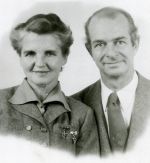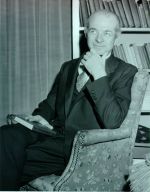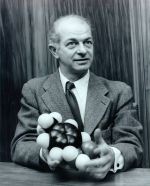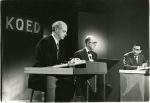
Middle Years: War Work, Peace Work and Protein Structure
| 1950 | College Chemistry: An Introductory Textbook of General Chemistry A less specialized version of General Chemistry, directed at undergraduates not majoring in the subject. Manuscripts and Typescripts of Books 6.002 (Catalogue Vol. I page 272) |
| 1950s | Scientific research / Anti-nuclear and peace activism Pauling’s scientific work in this period included continued work on crystal structure and the chemical bond, investigation of nucleic acids, various proteins including hemoglobin, helix structures, quantum mechanics, and in 1958 and 1959, molecular disease. In addition, he spoke out on nuclear weapons and disarmament. |
| 1950s | Research Notebooks Research notes from the 1950s appear in various notebooks. Box 20R has notes on the chemical bond, alloys, and anaesthesia. Boxes 23R-24R, 27R-31R, 35R, and 36R have notes from the 1950s and subsequent decades, and include various scientific and personal topics. See Catalogue for listing of research notebook contents View Online: Research Notebooks Boxes 20R, 23R, 24R, 27R-31R; 35R, 36R (Beginning with catalogue Vol. II page 99) |
| 1950s | Proteins / Crystallography / Chemical bond In the 1950s Pauling again takes up the study of proteins begun before the war. In particular, he investigates the chaining of molecules, and the possibility of a chain coiled into a helix shape that first occurred to him in 1948 – the alpha helix for which Pauling was famous. Pauling and Robert Corey published "one of the most extraordinary sets of papers in the history of twentieth-century science. . . The proposed [protein] structures were complete and extraordinarily detailed; in a field where nothing like this had ever appeared, suddenly everything had appeared. . . ." (Hager, Force of Nature, pp.378-379) The seven papers appeared in one issue of The Proceedings of the National Academy of Sciences in May, 1951. The most-cited ones are listed below. |
| 1951 | "The structure of proteins: two hydrogen-bonded helical configurations of the polypeptide
chain" View Online: Publications 1951p.8(Catalogue Vol. I page 118) "Atomic coordinates and structure factors for two helical configurations of polypeptide chains" View Online: Publications 1951p.9(Catalogue Vol. I page 118) "Configurations of polypeptide chains with favored orientations around single bonds: two new pleated sheets" Publications 1951p.20 (Catalogue Vol. I page 118) |
| 1953 | Proteins / Crystallography Two more much-cited papers by Pauling and Corey, from many written. "Stable configurations of polypeptide chains" Publications 1953p.2 (Catalogue Vol. I page 119) "Compound helical configurations of polypeptide chains: structure of proteins of the α-keratin type" Publications 1953p.5 (Catalogue Vol. I page 119) Pauling and his co-researchers published numerous papers in this period, many of them on protein research. For an example of Pauling’s own notes from his scientific research in this period, see – Structures of helixes Miscellaneous notes. Science 6.001 and 6.002 (Catalogue Vol. II pages 18-19) |
| 1950s | Proteins: Exhibit on Chemical Bond and Proteins, 1957-58 Universal International Exhibition in Brussels, International Science Section brochure stating the aim to synthesize scientific knowledge. Interesting for historical context. Establishes four divisions or bases of science: ATOM dealing with atomic physics; MOLECULE dealing with chemistry; CRYSTAL dealing with solid state physics; LIVING CELL dealing with biology. Note that molecular biology is not envisioned here. (Catalogue Vol. III page 233) |
| 1950s | Anti-nuclear and peace activism Pauling’s political stance evolved over time from Republican to left-liberal. He was always influenced by the thinking of Ava Helen, who was familiar with socialist thought, and he read books critical of the prevailing social and economic conditions. As early as 1939, Pauling read J.D. Bernal’s The Social Function of Science, in which Bernal, an English crystallographer and left thinker, argued that science, like other activities in society, is often bound to political and economic agendas, and does not operate free of them in objectivity. The approach of World War II in Europe and the attempts of Jewish European scientists to flee to England and the United States increased Pauling’s awareness of political effects on science, and the antagonistic local reaction to his and Ava Helen’s hiring of a Japanese gardener during the war may have further radicalized him. After the atomic bomb was dropped, the Emergency Committee of Atomic Scientists formed to tell the public that the bomb demanded that humanity adopt new thinking, and to promote world sharing of nuclear technology for peace. Pauling joined the committee, headed by Albert Einstein, and began to speak out against the arms race. This put him at odds with the cold war temper of the times and the anti-Communist crusade of the 1950s. For a few examples of many statements in his campaign against the use and testing of nuclear weapons, see – "The World Problem and the Hydrogen Bomb" View Online: Publications 1954p.5 (Catalogue Vol. I page 121) "Why Every Test Kills. . ." Publications 1958p.5 (Catalogue Vol. I page 123) "A First Step in Disarmament" Publications 1958p.7 (Catalogue Vol. I page 123) |
| 1954 | Nobel Prize for Chemistry Awarded to Pauling for his work on the chemical bond. This was a departure from the usual practice of giving the prize for a single important discovery. Throughout the 1950s, Pauling was investigated by U.S. government agencies in an anti-Communist campaign. Pauling was not a Communist, but repeated investigations, and his outspokenness, kept him under suspicion, and his right to travel to foreign scientific conferences was restricted. Pauling was not certain he would be allowed a passport to receive the Nobel Prize, and had to wait until just two weeks before the ceremony to hear that his passport had been approved. View Online:Nobel Prize for Chemistry Medal |
| 1957 | Petition to end nuclear testing Pauling, with the physicist Edward Condon and the biologist Barry Commoner, wrote a petition from American scientists to stop nuclear testing because of the dangers of fallout. Pauling, Ava Helen, and volunteers mailed the petition to scientists and universities, obtaining more than 2000 signatures, including leading scientists and Nobel prize winners. The petition was released to the press in June and sent to the United Nations and President Eisenhower. Peace 5.007-5.018 (Catalogue Vol. III pages 142-145) 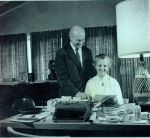 Linus and Ava Helen Pauling working on the United Nations Bomb Test Petition, 1957. LP Photographs, 1957i.48 |
| 1958 | International petition to end nuclear testing Pauling had continued with his petition efforts, and collected more than 9000 signatures from 43 countries, including 35 Nobelists. Pauling presented the petition to U.N. Secretary General Dag Hammarskjöld in January at a Nobelists’ banquet, and received much publicity. View Online: Peace 5.007 - 5.018a (Catalogue Vol. III pages 142-145) |
| 1958 | "Fallout and Disarmament: A Debate between Linus Pauling and Edward Teller" The debate was broadcast on television and later published in Daedalus: Proceedings of the American Academy of Arts and Sciences. Edward Teller, who became known as the "father of the hydrogen bomb" was an active proponent of nuclear testing in order to produce a low-fallout bomb to protect the free world from Communist threat. Manuscripts and Typescripts of Speeches 1958s.3 (Catalogue Vol. I page 216) View Online: Publications 1958p2.1 (Catalogue Vol. I page 123) |
| 1958 | No More War! In this book about the need to combat the genetic and political threat of nuclear weapons, written after the debate with Teller, Pauling asserted his conviction that scientists have a responsibility to share their scientific knowledge with the public, and to state their conclusions on matters of public concern. Manuscripts and Typescripts of Books 7.002 (Catalogue Vol. I page 274) |
Pauling’s political outspokenness lost him support at CIT over a period of many years, and he resigned his chairmanship there in 1958, although he remained there as a professor until 1963. He continued with his peace work, while his scientific work began to turn to the application of chemistry to medicine, and to molecular-level constituents of human health.
Table of Contents
- Introduction
- Ways to Approach the Curriculum
- Using Archival Materials in Special Collections
- Early Years: Education, Teaching and the Chemical Bond
- Middle Years: War Work, Peace Work and Protein Structure
- Part I: 1940-1949
- Part II: 1950-1959
- Part III: 1960-1965
- Later Years: Molecular Disease and Orthomolecular Medicine
- Topical Readings
- Websites Regarding Linus Pauling
- Appendix: General Guidelines for Use of Special Collections Materials
- Acknowledgements


